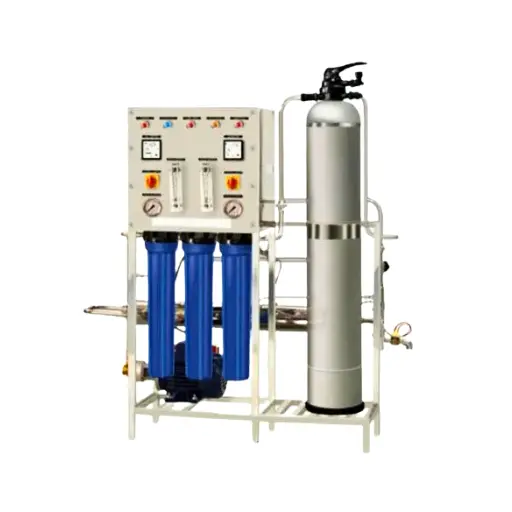High-Efficiency 200 LPH DM Plant
200 LPH Deionization (DM) Water Treatment Plant – High-Purity Water Solution
Product Advantages
- Advanced Deionization Process: Uses high-quality ion-exchange resins to remove dissolved solids, salts, and minerals.
- 200 LPH Capacity: Ideal for laboratories, pharmaceuticals, boilers, and other industries requiring ultra-pure water.
- High Purity Water Output: Achieves ultra-low TDS and conductivity for critical applications.
- Fully Automatic & Semi-Automatic Options: Available in manual, semi-automatic, and fully automatic models.
- Compact & Space-Saving Design: Suitable for installations with limited space.
- Low Maintenance & Easy Operation: Simple resin replacement and system upkeep for long-term reliability.
- Corrosion-Resistant Construction: Made from stainless steel/FRP for extended durability.
- Energy-Efficient Performance: Optimized for low power consumption.
- Customizable Filtration Stages: Can be modified to meet specific water quality needs.
- Ensures Consistent Quality: Stable and reliable output for high-precision applications.
Highlight Specifications:
| Feature | Specification |
|---|---|
| Capacity | 200 LPH |
| Technology | Ion-Exchange Deionization |
| Resin Type | Cation & Anion Exchange Resins |
| Power Consumption | 1-2 kW |
| Operating Voltage | 220V AC |
| Material | Stainless Steel/FRP |
| Automation | Fully Automatic/Semi-Automatic |
| TDS Reduction | Up to 99.9% |
| Conductivity Output | <1 Microsiemens/cm |
| Warranty | 1 Year |
Product Customer Care Number
For installation, maintenance, or troubleshooting support, contact our Customer Care Number: 8800199166. Our team is available 24/7 for assistance.
Product Related Do’s & Don’ts
Do’s:
- Replace resin as per the maintenance schedule to maintain purity levels.
- Regularly monitor the TDS and conductivity of output water.
- Keep the system in a dry, ventilated space for optimal performance.
- Use a voltage stabilizer to prevent power fluctuations.
- Follow the recommended maintenance schedule to ensure longevity.
Don’ts:
- Do not run the plant with exhausted resin; it affects water purity.
- Avoid using untreated high-TDS water without pre-filtration.
- Do not ignore system alarms or indicator signals.
- Never use unauthorized chemicals for cleaning or regeneration.
Product Repair Troubleshoots
Common Issues & Solutions:
- Reduced Water Purity: Resin may need regeneration or replacement.
- Slow Water Flow: Check for clogging in the filters or resin chambers.
- System Leakage: Inspect all pipe connections and O-rings for damage.
- Power Failure or No Operation: Ensure the power supply is stable and check electrical connections.
- High Conductivity in Output Water: Resin exhaustion might require regeneration or replacement.
Product Service Guide and Future Service Schedule Information
Maintenance Schedule:
- Pre-Filters: Replace every 3-6 months.
- Cation & Anion Resins: Regenerate every 3-6 months or replace annually, depending on usage.
- Pump & Motor Check-up: Every 6 months.
- Annual System Inspection: Recommended for ensuring optimal efficiency and longevity.
Service Assistance:
Enroll in our Annual Maintenance Contract (AMC) for hassle-free servicing and uninterrupted plant performance.
Product Installation Guide
- Choose an Appropriate Location: Ensure access to a water source and proper drainage.
- Connect the Components: Properly assemble the inlet, resin chambers, and outlet.
- Power Setup: Use a stabilizer to prevent voltage fluctuations.
- Initial Rinse: Flush the system with clean water to remove any initial residues.
- Check for Leaks: Inspect connections before full operation.
For professional installation, contact our support team.
FAQs
Q1: What is the ideal input water TDS for this DM Plant?
A1: The system is designed for water with TDS below 1000 ppm. Pre-treatment may be needed for higher levels.
Q2: How often should the resin be replaced or regenerated?
A2: The resin should be regenerated every 3-6 months and replaced annually, based on usage.
Q3: What is the warranty period?
A3: The plant comes with a 1-year warranty covering manufacturing defects.
Q4: Can I install the DM Plant myself?
A4: Professional installation is recommended for proper setup and warranty validation.
Q5: How much power does this system consume?
A5: The plant operates within 1-2 kW, depending on flow rate and operational hours.
Q6: Does the system remove bacteria and viruses?
A6: While DM plants mainly remove dissolved ions, an additional UV or RO stage is recommended for microbial control.
